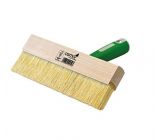
Paint Brushes
-

Osmo Oil Floor Brush Head (220)
From:£36.96(inc VAT)
Paint brush or roller: which is better?
Paint brushes and rollers are both great tools for decorating but have strengths in different areas. You should use a brush when you need more control and greater dexterity for painting things like corners and edges, whereas a roller is more appropriate when you want to cover a lot of space quickly.
Rollers will leave behind a thin and even coat of paint, but the finish will depend on the surface of the roller. Choose a smooth roller for a smooth finished, or a thicker and fluffier roller for a more textured finish.
There are many types of brush available too and you should always match the brush to the job, both in terms of size and whether you choose a natural bristle brush or a synthetic brush. Be aware that using a paint brush is likely to leave behind a slightly textured surface in the form of brushstrokes.
How to clean paint brushes?
The best way to protect your brushes in the first place is to make sure you don’t load up the brush with more paint than you need. Once you are finished painting you should begin cleaning your brush immediately so the paint doesn’t have any chance to start drying.
Hold the bristles under a running tap of warm water and massage the bristles, using your thumbs to press down and out to push the paint off the brush and into the sink. Angle the brush downwards to ensure the paint runs away rather than further down into the brush and getting clogged, as this will make it harder to clean and cause damage to the bristles. If you are really struggling to get paint out of the bristles, you could use a metal comb to brush through and dislodge any stubborn areas.
To dry, dab the wet brush on a soft towel a couple of times. Then roll the handle of the brush between your palms to shake out any remaining water droplets.
How to paint a wall with a brush?
If you are painting a wall, we highly recommend using a paint roller to cover the vast majority of the surface area. BUT you should be using a paint brush to carefully cover the corners and edges to give you more control and greater dexterity to get into all the little nooks.
Make sure you are using a good quality brush and if you are using a water based paint, wet your brush before dipping it into the paint. This will stop the paint from hardening on the bristles which are lower down, which will extend the life of your brush.
Wipe both sides of the brush off on the edge of the paint can to remove excess paint. For painting corners, use the very tip of the brush to paint a straight, smooth line down the length of the wall or along near the ceiling. You can then follow up with the full width of the brush to fill out the edges more.
Be sure to go over this again and feather the edges by quickly passing over the hard edge of where the brush ended, as this will avoid there being a visible line where the width of the brush ends. As you are painting, tilt the brush forward when dragging it along to wipe the paint off the edge first which will allow you to keep finding fresh paint as you progress along the brushstroke.
Once you have covered the corners and edges of your wall, you can transition to a paint roller to allow you to paint the rest of your wall much more quickly and easily.

